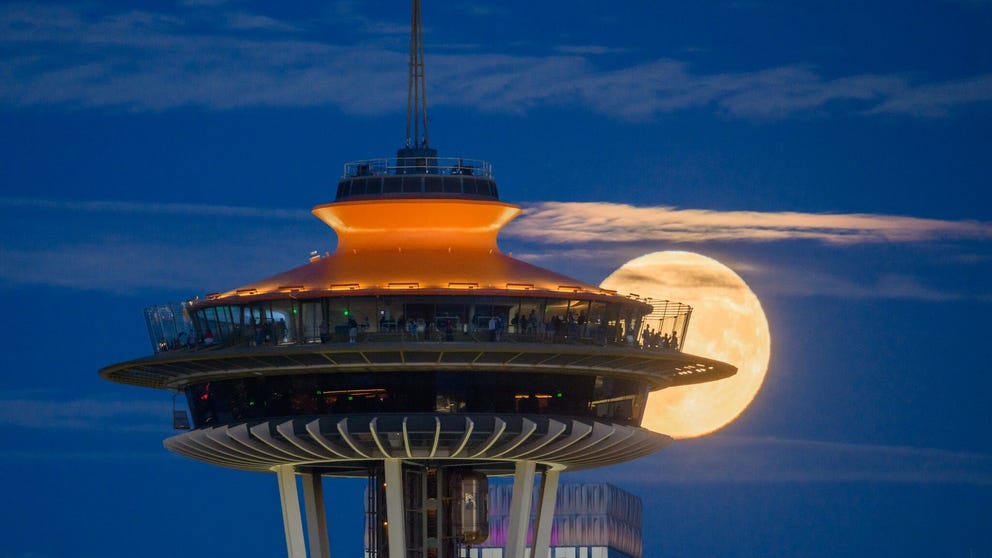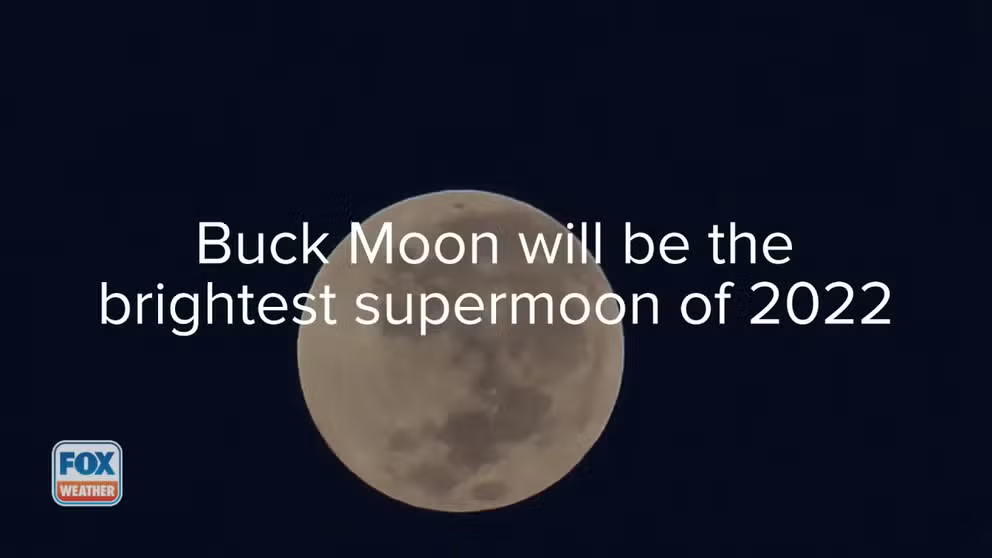Moon shot: The quest for the perfect Full Buck Supermoon photo
Standout Seattle photographer Tim Durkan shares his adventure in snapping the perfect Full Buck Supermoon over the Space Needle Wednesday night.
Full Buck Supermoon photos from around the world
Photographers were out in force to capture the beauty of the full Buck Moon that was also a super moon!
SEATTLE -- The invitation Wednesday for a one-of-a-kind full moon viewing experience was simple yet nearly a decade in the making: Meet just after sunset at Seattle's iconic Kerry Park, which offers stunning views of the downtown skyline, including the Space Needle and Mt. Rainier.
This wasn't just any ordinary full moon though; it was the brightest "supermoon" of the year and coming during one of the few months you could reasonably bank on clear weather in the Pacific Northwest. And Mother Nature didn't disappoint.
JULY'S FULL BUCK MOON WILL BE THE BRIGHTEST SUPERMOON OF THE YEAR
I arrived with my teen daughter, who is also a bit of a photography buff, to find we were certainly not alone in the idea of catching a glimpse of the supermoon over the skyline.
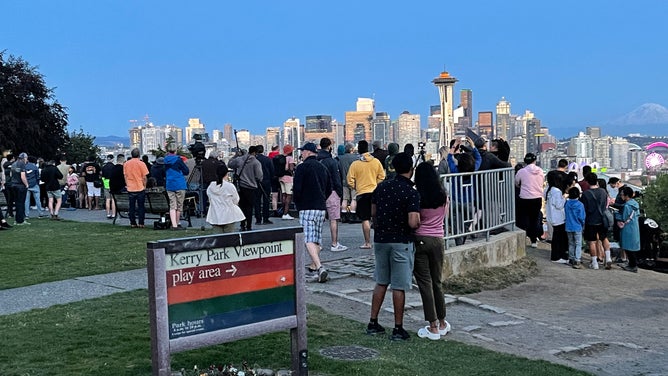
Dozens gather at Seattle's Kerry Park in hopes of catching a glimpse of the Full Buck Supermoon on July 13, 2022.
(Scott Sistek / FOX Weather)
Several onlookers stood shoulder to shoulder with dozens of photographers and their tripods crammed along and around the park's railing, trying to claim their spot for what promised to be a print-worthy shot.
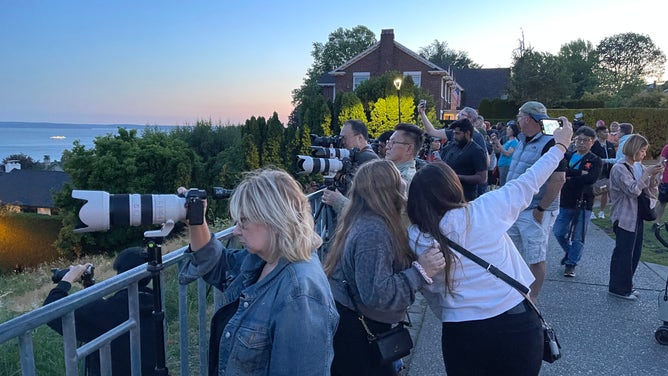
Dozens gather at Seattle's Kerry Park in hopes of catching a glimpse of the Full Buck Supermoon on July 13, 2022.
(Scott Sistek / FOX Weather)
My cell phone soon buzzed and on the other end was Tim Durkan, a professional photographer who is well known around these parts for his iconic moon photos framed around the Space Needle. His photos have garnered tens of millions of views over the years on social media and his work adorns the walls of some of the city's most influential buildings. He's instantly recognizable to many photographers in the city.
My meteorology writing career and his photography career have crossed paths several times for nearly a decade in the city, as he has been gracious to always share his work when my stories needed that perfect photo. A photo he captured in his early moon photography days of a lunar eclipse perfectly framed over the Space Needle went viral with millions of views on one of my weather blog's social media channels and we've been connected since. We hadn't met in person yet, and that was finally changing tonight.
July's full moon will be the brightest supermoon of 2022
The full moon on July 13, known as the Buck Moon, will be about 17,000 miles closer to Earth.
But Tim wasn't one of the hordes of photographers crammed in the park. "Take the stairs down the side of the park down the hill and then take a right and meet me there," he said. "I'd come get you but if I'm spotted, we'll have more than a dozen photographers follow us back."
After ambling down the long staircase that leads 70 or so yards alongside Kerry Park, nestled on the rather steep Queen Anne Hill, I find Tim waiting in front of a house. He had been in the neighborhood scouting better filming locations along the street earlier in the week when he ran into one of the homeowners who had a private deck, a fantastic view of the Space Needle, and a willingness to allow Tim to just come on up and work his magic. They were gracious enough to let this wide-eyed meteorologist and budding photographer daughter join in.
We arrive to find Tim had two cameras set up already trained on the Space Needle and he readies their settings to factor in the eventual moon visit, which presents some challenges -- especially a supermoon. This month's full moon will be 17,000 miles closer to Earth than its average orbit.
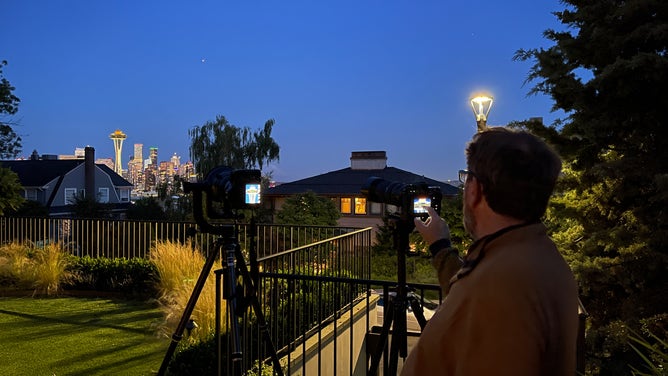
Tim Durkan awaits the arrival of the Full Buck Supermoon in Seattle on July 13, 2022.
(Scott Sistek / FOX Weather)
"It's noticeably brighter (than a typical full moon)," Durkan said. "It's probably five times brighter than the Space Needle, which presents a big problem. You get a choice of having the moon exposed properly or the Space Needle exposed properly, and the moon is what you're taking a picture of. That means the Space Needle would be darker than you'd like."
7 TIPS FOR SHOOTING THE MOON… WITH A CAMERA
Full moons rise just after the sun sets, which up here in the North, waits until around 9 p.m. in the heart of summer. It takes until just past 10 p.m. for the moon to rise high enough to be spotted from behind the skyline. But when it does, it's breathtaking.
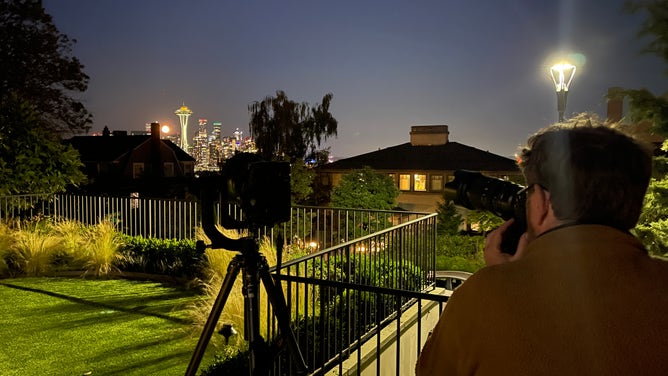
Tim Durkan snaps photos as the Full Buck Supermoon moves behind the Space Needle
(Scott Sistek / FOX Weather)
The moon first peeked out behind one skyscraper, then made a beeline for the Space Needle. The moon orbits the Earth at nearly 2,300 mph and nowhere is it more evident than when you have a frame of reference, such as skyline, to see just how fast the moon scoots across the sky.
Tim gets to work whirring away on both cameras and preparing for the moments when the moon and Space Needle join together, making sure the lighting is just right on the moon. "You want to get enough detail to see the craters -- that's the goal," he said.
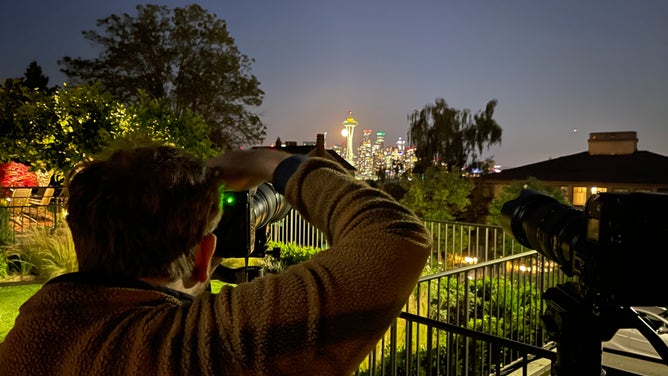
Tim Durkan snaps photos as the Full Buck Supermoon moves behind the Space Needle
(Scott Sistek / FOX Weather)
We had hoped going into the evening that the moon might possibly align with the top "needle on the Needle" -- but the moon's trajectory is coming in too low from our vantage point. Instead, the Needle is going to "catch the moon in its bucket."
Durkan has taken hundreds of moon shots with the Needle over the years and each one has their own surprise and quirk, he says. He tries to nail a shot where the moon hangs just below the observation deck, framed when an elevator drops down and crosses the moon.
"I used to get all worked up trying to get the perfect shot," Durkan said. "When I realized it was the effort in the sentiment that others were drawn to and not just the perfect alignment. It was there I drew my philosophy that you don't always get the shot that you want, but the shot you were meant to have."
PHOTOS: FULL BUCK SUPERMOON PUTS ON A SHOW, AND IT'S NOT DONE YET
His digital card fills with photos as the moon races through, then begins its escape from the Needle's grasp as if watching a manmade eclipse. At one point during the exit, the moon glances along the outer rail of the observation deck showcasing part of the original 1962 design of the city's best-known landmark.
This will be the winning shot of the night.
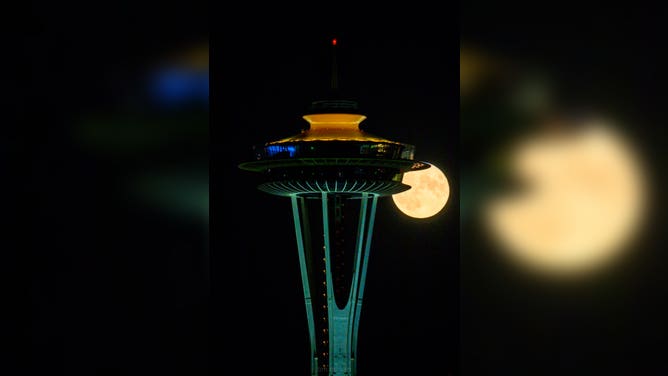
The Full Buck Supermoon slides near Seattle's Space Needle on July 13, 2022.
(Tim Durkan Photography)
As the moon pulls away further, Durkan pulls out his laptop and gets to work. The race is on to post his best shot to social media.
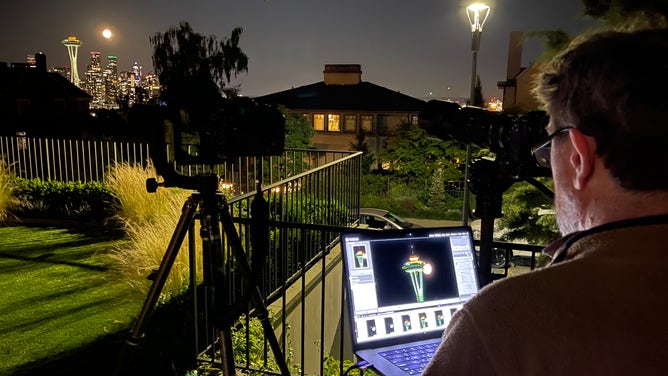
Photographer Tim Durkan works on editing his moon shot of the night moments after the full moon pulls away from the Space Needle.
(FOX Weather)
After a few minutes of cleaning up the shot and getting rid of some "noise", Durkan sends it to his cell phone and moments later it's on Twitter, Instagram, Facebook… and the likes instantly start pouring in.
"I love making moon alignment photos because they are contrary to what I see around me much of the time, which can be a little chaotic," Durkan said. "Also, the moon is such a celestial dichotomy. It seems so lonely sitting out there by itself but at the same time such an omnipresent force on human cultures dating back thousands of years. It deserves some photographic attention."
One more night to catch the full supermoon
If you've missed the shows Tuesday and Wednesday night or this story inspired you to make your own moon photo attempt, the moon will still appear just about full again Thursday night and still be brighter than usual due to the closer pass on its elliptical orbit.
Still unable to get outside or socked in with clouds? Try again on the evening of Aug. 11.
The full "Sturgeon" moon also qualifies as a "supermoon" meaning it's nearing its closest point to Earth during its full phase, according to The Farmer's Almanac. The moon won't be quite as close as July's supermoon, but it will still appear a slightly bit larger and brighter than an average full moon.
Durkan says with a little planning ahead, you can frame the moon how you wish.
"The easiest way to pick up a great spot to photograph the moon is to first find out where it will be coming up or setting," he said. "With that information you simply draw a straight line through the moon and photograph anything that falls on or near it!"
